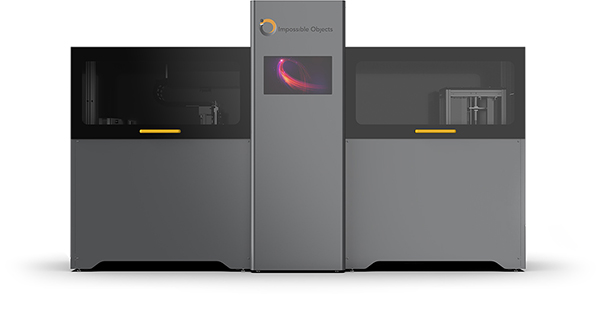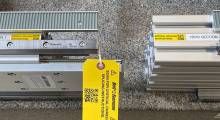At RAPID + TCT 2019, Impossible Objects announced two advances in composite 3D printing for the factory floor. The company’s latest 3D printing system, the CBAM-2, and a new partnership with BASF on PA6-carbon fiber composites extend Impossible Objects’ composite based additive manufacturing process (CBAM) to a range of industrial applications.
“It’s been exciting to see how our customers are putting our approach to work to create high-performance parts for everything from aircraft and cars to lightweight athletic gear,” says Impossible Objects founder and chairman Bob Swartz. “We’re continuing to bring machines, materials and expertise to the market to transform the entire manufacturing process, from prototyping through to high-volume production.”
CBAM-2 Speeds Production of 3D Parts at Scale
The new CBAM-2 3D printing system, being shown at RAPID + TCT for the first time, delivers complex parts on an industrial scale—speeding up the additive manufacturing process. The CBAM-2 combines high-performance polymers with long-fiber carbon and fiberglass sheets to produce 3D composite parts that are stronger, lighter with better temperature performance and more durable than possible with conventional 3D printing methods.
Since Impossible Objects launched its flagship Model One 3D printer at RAPID 2017, a growing number of Fortune 500 companies have adopted it. Customers include major automotive manufacturers including Ford Motor Company, manufacturing services company Jabil, the U.S. Air Force, and the National Institute for Aviation Research (NIAR), among others.
Features of the CBAM-2 include:
Production speed: The machine can produce high volumes of production parts quickly—up to 10x faster than conventional 3D printing, according to the company.
Support for high-strength composites: The CBAM-2 can print 3D parts from composites that are not available through any other 3D printing method. Combining carbon fiber and fiberglass with high-performance thermoplastics like PEEK and Nylon can produce parts with better strength-to-weight ratios than metals, along with superior temperature performance and chemical resistance.
Support for larger parts: Printed sheets can now reach up to 12 inches x 12 inches in size.
Increased precision: The CBAM-2 features three added cameras.
Streamlined maintenance: Automatic powder filling reduces fill-time to days, and bulk ink cartridges eliminate the need to refill ink frequently, allowing machines to run efficiently at a significantly greater duration.
CBAM-2 machines will be available for customers beginning in Q3.
In other news, Impossible Objects also announced that through a collaboration with BASF, its Model One and CBAM-2 printers will support BASF’s Ultrasint PA6 (polyamide 6) powder, allowing customers to 3D print high-performance carbon fiber-PA6 composite parts for the first time.
“Our collaboration with Impossible Objects opens up new possibilities for customers, especially in the automotive and industrial sectors where we’re seeing strong demand for PA6. This partnership is in line with our philosophy of open innovation and support for open platforms. We’re encouraged by how Impossible Objects is using PA6 and are excited to work together to advance the state of additive manufacturing,” sayd Kara Noack, regional business director for BASF 3D Printing Solutions.
“We’re honored to be collaborating with BASF 3D Printing Solutions to make this economical workhorse polymer, which is used in an enormous number of industrial applications, available to our customers,” adds Bob Swartz of Impossible Objects.
PA6 adds to Impossible Objects’ currently supported materials and will be available for shipment in Q3.
In more news, to meet the demand for its products, Impossible Objects has raised $4.1 million in funding in a round led by returning investor OCA Ventures, bringing total funding to more than $13 million. The company raised $6.4 million in Series A funding in October 2017 from OCA Ventures, IDEA Fund Partners, Mason Avenue Investments, Huizenga Capital Management and Inflection Equity Partners.
Sources: Press materials received from the company and additional information gleaned from the company’s website.
About the Author
Press releases may be sent to them via [email protected]. Follow Robotics 24/7 on Facebook
Follow Robotics 24/7 on Linkedin
Article topics
Email Sign Up
















